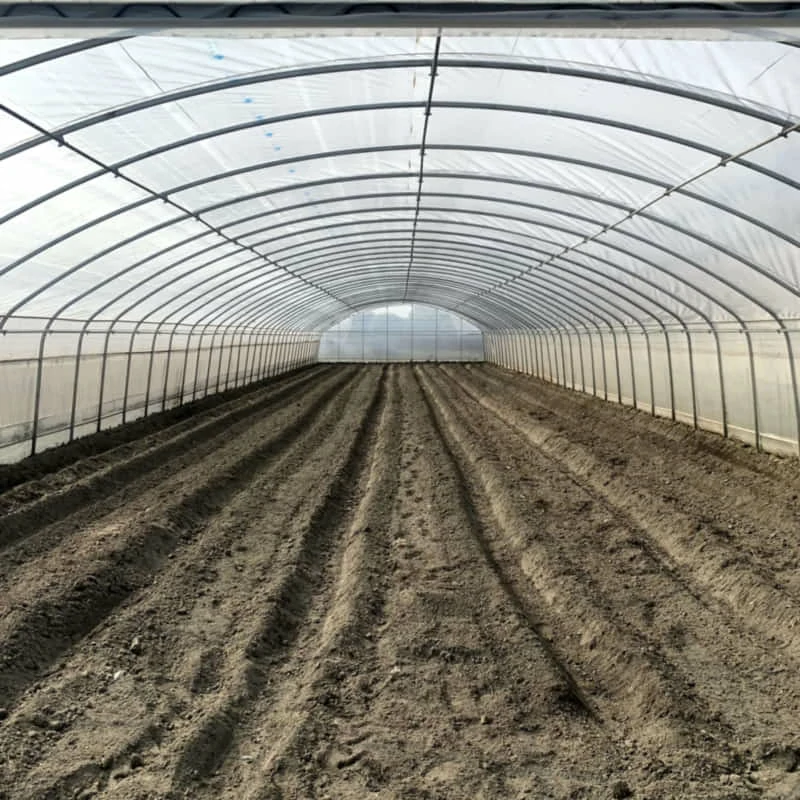When judging the quality of greenhouse plastic film, there are several factors to consider.
Here are some key aspects to assess:
- Light Transmission: High-quality greenhouse plastic film should have excellent light transmission properties. It should allow a sufficient amount of sunlight to pass through while minimizing light scattering or diffusing. The film’s transparency directly impacts the growth and development of plants inside the greenhouse.
- UV Stability: Greenhouse plastic film should be UV stabilized to protect plants from harmful ultraviolet (UV) rays. UV stabilization prevents the film from degrading or yellowing over time due to prolonged exposure to sunlight. This ensures the longevity of the film and maintains its light transmission properties.
- Strength and Durability: The film should be strong and durable to withstand environmental stressors, such as wind, rain, and temperature fluctuations. Look for films that have high tear resistance, puncture resistance, and tensile strength. These qualities will help prevent damage and ensure the film’s longevity.
- Thermal Properties: The greenhouse plastic film should provide good insulation properties to regulate the temperature inside the greenhouse. Look for films that have good heat retention properties during cooler periods and effective heat dissipation during warmer periods. This helps create a stable and favorable growing environment for plants.
- Anti-Condensation Properties: Condensation can occur inside the greenhouse, leading to droplets that can negatively impact plant health. High-quality greenhouse plastic film may have anti-condensation properties, such as a special coating or treatment, to minimize condensation formation and improve light transmission.
- Anti-Drip Properties: Some greenhouse films have anti-drip additives that help prevent the formation of large water droplets on the film’s inner surface. This reduces the risk of water dripping onto plants, which can cause disease and damage.
- Lifespan and Warranty: Consider the expected lifespan of the greenhouse plastic film and any warranties provided by the manufacturer. Longer-lasting films with warranties indicate higher quality and durability.
When evaluating greenhouse plastic film, it’s advisable to consult with reputable suppliers or manufacturers who can provide detailed information about the film’s specifications, certifications, plastic greenhouse film and performance. Additionally, reading customer reviews and seeking recommendations from experienced growers can be helpful in assessing the quality and reliability of specific greenhouse films.
When evaluating the quality of greenhouse plastic film.
Here are some more considerations:
- Anti-Fogging Properties: In high humidity environments, condensation can form on the greenhouse film, leading to fogging that reduces light transmission. Look for films that have anti-fogging properties to minimize fog formation and maintain optimal light levels for plant growth.
- Diffusion and Light Distribution: Some greenhouse films are designed with light-diffusing properties. These films scatter light more evenly throughout the greenhouse, reducing shadows and hotspots. Diffused light can promote more uniform plant growth and minimize stress on plants.
- Anti-Static Properties: Certain greenhouse films are treated to be anti-static, which helps prevent dust and dirt from adhering to the surface. This reduces the need for frequent cleaning and ensures maximum light transmission.
- Thickness and Weight: Consider the thickness and weight of the greenhouse film. Thicker films generally offer increased durability and resistance to tearing, but they can reduce light transmission. Balancing the thickness and weight with light transmission requirements is important.
- Environmental Considerations: Evaluate the environmental impact of the greenhouse film. Look for films that are recyclable or made from recycled materials. Additionally, consider any certifications or standards the film meets, such as being free from harmful chemicals or complying with relevant industry regulations.
- Installation and Maintenance: Assess the ease of installation and maintenance requirements of the greenhouse film. Some films may come with specific installation guidelines or require specialized equipment. Understanding the maintenance procedures, such as cleaning recommendations or anti-dust treatments, can help ensure optimal performance.
- Cost: While cost shouldn’t be the sole factor in determining quality, it’s important to consider the price of the greenhouse film in relation to its features and expected lifespan. Cheaper films may have lower quality and durability, leading to more frequent replacements and higher long-term costs.
Remember that different greenhouse applications and climates may require different film characteristics. It’s essential to select a greenhouse plastic film that aligns with your specific needs, crop requirements, and environmental conditions. Consulting with experts or experienced growers in your region can provide valuable insights and recommendations for the most suitable greenhouse film options.
